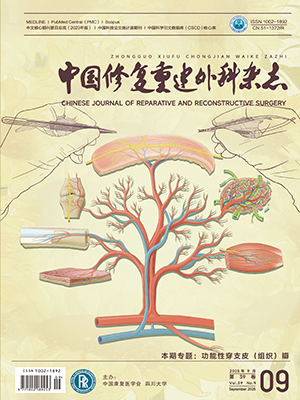| 1. |
Fillingham Y, Jacobs J. Bone grafts and their substitutes. Bone Joint J, 2016, 98-B (1 Suppl A): 6-9.
|
| 2. |
Fillingham YA, Cvetanovich GL, Haughom BD, et al. Bioceramic bone graft substitute for treatment of unicameral bone cysts. J Orthop Surg (Hong Kong), 2016, 24(2): 222-227.
|
| 3. |
Nguyen TB, Lee BT. A combination of biphasic calcium phosphate scaffold with hyaluronic acid-gelatin hydrogel as a new tool for bone regeneration. Tissue Eng Part A, 2014, 20(13): 1993-2004.
|
| 4. |
Orellanaa BR, Thomasb MV, Dziublac TD, et al. Bioerodible calcium sulfate/poly (β-amino ester) hydrogel composites. J Mech Behav Biomed Mater, 2013, 26(10): 43-53.
|
| 5. |
Sawatjui N, Damrongrungruang T, Leeanansaksiri W, et al. Silk fibroin/gelatin-chondroitin sulfate-hyaluronic acid effectively enhances in vitro chondrogenesis of bone marrow mesenchymal stem cells. Mater Sci Eng C Mater Biol Appl, 2015, 52: 90-96.
|
| 6. |
Solis MA, Chen YH, Wong TY, et al. Hyaluronan regulates cell behavior: a potential niche matrix for stem cells. Biochem Res Int, 2012, (2012): 346972.
|
| 7. |
Wu AT, Aoki T, Sakoda M, et al. Enhancing osteogenic differentiation of MC3T3-E1 cells by immobilizing inorganic polyphosphate onto hyaluronic acid hydrogel. Biomacromolecules, 2015, 16(11): 166-173.
|
| 8. |
Kumar CY, K B N, Menon J, et al. Calcium sulfate as bone graft substitute in the treatment of osseous bone defects, a prospective study. J Clin Diagn Res, 2013, 7(12): 2926-2928.
|
| 9. |
Zhang C, Li Z, Li Q, et al. Properties and Osteogenicity of Two Calcium Sulfate Materials with Micro or Nano Morphology. J Nanosci Nanotechnology, 2016, 16(3): 2277-2282.
|
| 10. |
Fillingham YA, Cvetanovich GL, Haughom BD, et al. Bioceramic bone graft substitute for treatment of unicameral bone cysts. J Orthop Surg (Hong Kong), 2016, 24(2): 222-227.
|
| 11. |
Mao K, Zhou F, Cui F, et al. Preparation and properties of α-calcium sulphate hemihydrate and β-tricalcium phosphate bone substitute. Biomed Mater Eng, 2013, 23(3): 197-210.
|
| 12. |
Brown ME, Zou Y, Dziubla TD, et al. Effects of composition and setting environment on mechanical properties of a composite bone filler. J Biomed Mater Res Part A, 2013, 101(4): 973-980.
|
| 13. |
Cheng P, Han P, Zhao C, et al. High-purity magnesium interference screws promote fibrocartilaginous entheses regeneration in the anterior cruciate ligament reconstruction rabbit model via accumulation of BMP-2 and VEGF. Biomaterials, 2016, 81: 14-26.
|
| 14. |
李阳, 雷伟, 王征, 等. 生物玻璃和壳聚糖改性的多孔活性骨水泥体内实验研究. 中国修复重建外科杂志, 2013, 27(3): 320-325.
|
| 15. |
Zhao N, Wang X, Qin L, et al. Effect of hyaluronic acid in bone formation and its applications in dentistry. J Biomed Mater Res A, 2016, 104(6): 1560-1569.
|
| 16. |
Hulsart-Billström G, Yuen PK, Marsell R, et al. Bisphosphonate-linked hyaluronic acid hydrogel sequesters and enzymatically releases active bone morphogenetic protein-2 for induction of osteogenic differentiation. Biomacromolecules, 2013, 14(9): 3055-3363.
|
| 17. |
Bae MS, Kim JE, Lee JB, et al. ZrO
2 surface chemically coated with hyaluronic acid hydrogel loading GDF-5 for osteogenesis in dentistry. Carbohydr Polym, 2013, 92(1): 167-175.
|
| 18. |
Qi X, Li H, Qiao B, et al. Development and characterization of an injectable cement of nano calcium-deficient hydroxyapatite/multi (amino acid) copolymer/calcium sulfate hemihydrate for bone repair. Int J Nanomedicine, 2013, 8: 4441-4452.
|
| 19. |
Kim YK, Lee JY, Kim SG, et al. Guided bone regeneration using demineralized allogenic bone matrix with calcium sulfate: case series. J Adv Prosthodont, 2013, 5(2): 167-171.
|
| 20. |
Yang X, Li Y, Huang Q, et al. Evaluation of a biodegradable graft substitute in rabbit bone defect model. Indian J Orthop, 2012, 46(3): 266-273.
|
| 21. |
Cao L, Weng W, Chen X, et al. Promotion of in vivo degradability, vascularization and osteogenesis of calcium sulfate-based bone cements containing nanoporous lithium doping magnesium silicate. Int J Nanomedicine, 2017, 12: 1341-1352.
|
| 22. |
Komorowicz E, Balázs N, Varga Z, et al. Hyaluronic acid decreases the mechanical stability, but increases the lytic resistance of fibrin matrices. Matrix Biol, 2016. [Epub ahead of print].
|
| 23. |
Gómez-Aristizábal A, Kim KP, Viswanathan S. A Systematic Study of the Effect of Different Molecular Weights of Hyaluronic Acid on Mesenchymal Stromal Cell-Mediated Immunomodulation. PLoS One, 2016, 11(1): e0147868.
|
| 24. |
Kwon TR, Seok J, Jang JH, et al. Needle-free jet injection of hyaluronic acid improves skin remodeling in a mouse model. Eur J Pharm Biopharm, 2016, 105(8): 69-74.
|
| 25. |
Wu PT, Kuo LC, Su FC, et al. High-molecular-weight hyaluronic acid attenuated matrix metalloproteinase-1 and -3 expression via CD44 in tendinopathy. Sci Rep, 2017, 7(1): 40840.
|
| 26. |
Lin WJ, Lee WC, Shieh MJ. Hyaluronic acid conjugated micelles possessing CD44 targeting potential for gene delivery. Carbohydr Polym, 2017, 155(1): 101-108.
|
| 27. |
Esguerra KV, Tolg C, Akentieva N, et al. Identification, design and synthesis of tubulin-derived peptides as novel hyaluronan mimetic ligands for the receptor for hyaluronan-mediated motility (RHAMM/HMMR). Integr Biol (Camb), 2015, 7(12): 1547-1560.
|
| 28. |
Savage JR, Pulsipher A, Rao NV, et al. A Modified Glycosaminoglycan, GM-0111, Inhibits Molecular Signaling Involved in Periodontitis. PLoS One, 2016, 11(6): e0157310.
|




